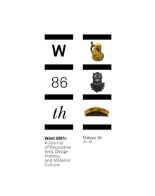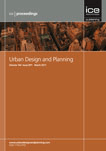
Design and Culture
Scope & Guideline
Transforming Perspectives on Design and Cultural Practices
Introduction
Aims and Scopes
- Socially Engaged Design:
The journal emphasizes the role of design in social change, exploring how design can be a tool for activism and community engagement, particularly in addressing issues of equity and justice. - Cultural Context and Identity:
Many publications investigate the relationship between design and cultural identity, examining how design practices shape and reflect cultural narratives and heritage. - Decolonial and Inclusive Design:
A significant focus is on decolonization in design, advocating for practices that are inclusive and sensitive to diverse cultural perspectives, particularly from historically marginalized communities. - Human-Centered and Participatory Approaches:
The journal promotes human-centered design methodologies that prioritize user experience and participatory design processes, ensuring that the voices of diverse stakeholders are heard and integrated into design solutions. - Interdisciplinary Perspectives:
By incorporating insights from fields such as anthropology, sociology, and political theory, the journal encourages a comprehensive understanding of design that transcends traditional boundaries. - Critical Examination of Design Practices:
There is a consistent focus on critiquing existing design practices, exploring ethical implications, and advocating for a more responsible and reflective approach to design.
Trending and Emerging
- Design for Social Justice:
An increasing number of publications focus on design as a means of advocating for social justice, emphasizing the role of designers in challenging systemic inequalities and fostering community empowerment. - Participatory and Collaborative Design:
There is a growing emphasis on participatory design approaches, where stakeholders are actively involved in the design process, reflecting a shift towards more inclusive and democratic practices. - Sustainability and Ecological Design:
Emerging themes around ecological design and sustainability are becoming more prominent, as the journal explores how design can address environmental challenges and promote sustainable practices. - Interdisciplinary and Cross-Cultural Dialogues:
Recent publications highlight the importance of interdisciplinary collaborations and cross-cultural dialogues in design, reflecting a broader understanding of design's role in global contexts. - Technology and Design Ethics:
With the rise of technology in design, there is an increasing focus on ethical considerations surrounding artificial intelligence and data use in design practices, emphasizing the need for responsible innovation.
Declining or Waning
- Historical Design Analysis:
Though historical perspectives on design continue to be relevant, there appears to be a waning interest in purely historical analyses without direct connections to contemporary implications or cultural narratives. - Commercial Design Practices:
The focus on traditional commercial design practices, such as branding and marketing, has diminished as the journal shifts towards more socially and culturally engaged topics that prioritize community needs over corporate interests. - Aesthetic-Centric Design Discussions:
Discussions centered solely on aesthetic value or trends in design are less frequent, as the journal emphasizes critical and ethical considerations over mere visual appeal. - Traditional Design Methodologies:
There is a noticeable decline in publications that adhere strictly to conventional design methodologies, as the journal increasingly advocates for innovative and experimental approaches that challenge the status quo.
Similar Journals

Design Studies
Illuminating the Path of Architectural ExcellenceDesign Studies, published by Elsevier Science Ltd, is an esteemed international journal, recognized for its pivotal contributions to the fields of design, architecture, and engineering. With an impressive history spanning from 1979 to 2024, this journal holds top positions in various categories, including Q1 rankings in Architecture, Arts and Humanities, and Engineering, indicating its high impact and relevance within academic circles. It boasts a notable Scopus ranking of #3 in Engineering & Architecture and #10 in General Social Sciences, demonstrating its multidisciplinary influence and the value it brings to both theoretical and practical aspects of design. Although not an open-access publication, the journal provides comprehensive access options to facilitate the dissemination of groundbreaking research. Catering to researchers, professionals, and students alike, Design Studies aims to foster innovation by publishing high-quality articles that explore contemporary design challenges and solutions, making it an essential resource for those invested in advancing knowledge in this dynamic field.

METU Journal of the Faculty of Architecture
Exploring the intersection of theory and practice in architecture.METU Journal of the Faculty of Architecture is a reputable academic publication dedicated to advancing research and discourse in the field of architecture. Published by MIDDLE EAST TECHNICAL UNIVERSITY in Turkey, this journal serves as a vital platform for scholars and practitioners, addressing both theoretical and practical topics relevant to contemporary architectural studies. With an impact factor that positions it in the Q3 category for architecture as of 2023, and a Scopus rank of #133 out of 189 in Engineering Architecture, the METU Journal is an influential resource for innovative ideas and studies. Encompassing a wide range of scholarly articles, it fosters academic collaboration between researchers and professionals, making it essential reading for anyone passionate about the evolution of architecture. Though not open access, it provides crucial insights and rigorous research from 2008 up until 2024, contributing significantly to the global discourse on architectural practices and theories.

Architecture_MPS is a premier open-access journal published by UCL PRESS, dedicated to exploring the interconnections between architecture, urbanism, and the broader spectrum of social and cultural dynamics. Launched in 2012, this journal stands as a crucial platform for researchers, practitioners, and students alike, facilitating the exchange of innovative ideas and comprehensive scholarship in the field. With its commitment to open access, Architecture_MPS significantly enhances the visibility and accessibility of research, fostering a collaborative environment for academic discourse. The journal covers a diverse array of topics, including theoretical frameworks, policy analysis, and practical case studies, making it an invaluable resource for those engaged in the study and practice of architecture and allied disciplines. As a leading source of contemporary research, Architecture_MPS aims to bridge gaps between academia and practice, encouraging interdisciplinary dialogues that shape the future of architecture and urban studies.

She Ji-The Journal of Design Economics and Innovation
Exploring the Convergence of Design, Economics, and InnovationShe Ji - The Journal of Design Economics and Innovation is a pioneering Open Access journal published by Elsevier since 2015, based in the Netherlands. With its unique focus on the intersection of design, economics, and innovation, this journal serves as a vital platform for researchers, professionals, and students who are keen on understanding the complexities of designing value-creating innovations. Consistently recognized for its high impact, She Ji holds a prestigious Q1 quartile ranking in both Economics and Education, while maintaining a strong presence in Management of Technology and Innovation and the Visual Arts sector. This reflects its commitment to fostering interdisciplinary dialogue and advancing knowledge in the rapidly evolving fields of design and economic theory. Researchers seeking to disseminate their work can benefit from the journal's robust open access model, ensuring wide visibility and accessibility to their findings. With a commitment to excellence, She Ji continues to shape thought leadership in its field and is an essential resource for anyone involved in the integration of design thinking with economic innovation.

West 86th-A Journal of Decorative Arts Design History and Material Culture
Revealing the Rich Tapestry of Design HistoryWest 86th: A Journal of Decorative Arts, Design History, and Material Culture, published by University of Chicago Press, stands as a significant publication within the arts and humanities, particularly focusing on the interconnections among decorative arts, design history, and material culture. With its ISSN 2153-5531 and E-ISSN 2153-5558, this journal has evolved since its inception in 2011, diligently contributing to a deeper understanding of visual arts and their historical context. Although categorized in the fourth quartile for the year 2023 within Visual Arts and Performing Arts, it ranks #387 out of 667 in Scopus, showcasing a unique niche with a commitment to quality scholarship. Researchers, professionals, and students engaged in these dynamic fields are encouraged to explore this journal as it provides insightful analyses and discussions that enrich the dialogue on the significance and impact of material culture. While it is not open access, the journal’s contributions remain integral for those seeking to deepen their knowledge and appreciation of decorative arts and design history.

DESIGN ISSUES
Advancing Scholarly Conversations in DesignDESIGN ISSUES, published by MIT PRESS, serves as a vital platform for scholarly discourse within the realms of design, arts, and humanities. With an ISSN of 0747-9360 and an E-ISSN of 1531-4790, this journal has established itself as a critical resource for researchers and practitioners alike, maintaining a significant presence in the academic community. As of 2023, it is ranked in the second quartile in Arts and Humanities (Miscellaneous) and the fourth quartile in Computer Graphics and Computer-Aided Design, showcasing its diverse scope and interdisciplinary approach. Spanning converged years from 2005 to 2024, DESIGN ISSUES fosters an exploration of contemporary design debates, theoretical advancements, and case studies, ensuring that it remains relevant and insightful amid the fast-evolving landscape of design practices. While not an open access journal, it is dedicated to enriching the academic and professional realms by engaging with pressing design issues, making it an essential read for anyone invested in the future of design.

Proceedings of the Institution of Civil Engineers-Urban Design and Planning
Unpacking the Complexities of Urban DevelopmentProceedings of the Institution of Civil Engineers-Urban Design and Planning is a leading scholarly journal published by EMERALD GROUP PUBLISHING LTD, dedicated to advancing knowledge and innovation in the fields of urban design and planning. With an ISSN of 1755-0793 and E-ISSN 1755-0807, this journal serves as a vital platform for researchers, professionals, and students to disseminate impactful studies and findings. It boasts impressive rankings, including Q1 in Architecture and notable positions in Civil and Structural Engineering and Urban Studies, underscoring its significance in the academic community. The journal's scope encompasses a diverse array of topics relevant to urban environments, encouraging interdisciplinary dialogue and exploration. Although it operates under traditional access, its contributions are invaluable, reflecting the latest developments and challenges within urban planning practices. Published regularly since 2009, the Proceedings of the Institution of Civil Engineers-Urban Design and Planning is vital for those seeking to enhance their understanding of sustainable urban development and design methodologies, making it a critical resource in its fields of study.

ArDIn-Arte Diseno e Ingenieria
Elevating Knowledge in Art, Design, and EngineeringArDIn-Arte Diseno e Ingenieria is a prominent open-access journal published by UNIV POLITECNICA MADRID, dedicated to advancing the fields of design and engineering. Since its inception in 2012, this journal has rapidly become an essential resource for researchers, professionals, and students alike, focusing on the integration of innovative practices and methodologies within the realms of art, design, and engineering. With an E-ISSN of 2254-8319, ArDIn fosters a platform for scholarly discussions, disseminating significant original research, reviews, and case studies that push the boundaries of interdisciplinary collaboration. Based in Madrid, Spain, the journal emphasizes the importance of accessibility in academic publishing, ensuring that a diverse audience can benefit from its high-quality content. As ArDIn continues to grow in reputation and impact, it remains committed to enhancing the knowledge landscape within the ever-evolving field of design and engineering.

ARQ
Showcasing pioneering ideas in architecture and conservation.ARQ, published by the Pontificia Universidad Catolica de Chile in the School of Architecture, is a pioneering open access journal established in 2001 that significantly contributes to the fields of architecture, conservation, and the visual and performing arts. Based in Santiago, Chile, this journal provides a vital platform for disseminating innovative research and critical discourse, showcasing diverse perspectives from scholars and professionals alike. With its impact evident in its prestigious Scopus rankings—placing it within the 44th percentile of Visual Arts and Performing Arts, the 26th percentile in Conservation, and the 23rd percentile in Engineering Architecture—ARQ demonstrates a commitment to elevating discourse within its discipline. The journal’s current categorization into different quartiles reflects its evolving scope and its aim to engage with contemporary challenges in architecture and related fields. Additionally, ARQ offers comprehensive open access options that enhance visibility and accessibility for its readership, fostering a collaborative and informed academic environment.

Design Journal
Advancing Interdisciplinary Insights in Arts and DesignDesign Journal, published by Routledge Journals, Taylor & Francis Ltd, serves as a pivotal platform for interdisciplinary research within the expansive fields of Arts and Humanities as well as Computer Graphics and Computer-Aided Design. With an ISSN of 1460-6925 and an E-ISSN of 1756-3062, this journal is dedicated to disseminating innovative ideas and methodologies that shape contemporary design practices. Ranked in the Q2 category in Arts and Humanities and Q3 in Computer Graphics per the 2023 category quartiles, it stands as a reference point for scholars and practitioners alike, fostering a vibrant community for sharing knowledge and fostering creativity. Researchers will find the journal's scope particularly valuable as it covers a diverse range of topics, providing insights critical for advancing knowledge and practice. With the journal continuing to evolve—converging research avenues from 2005 to 2024—it thrives as a beacon of scholarly excellence in the United Kingdom and beyond, appealing to professionals, researchers, and students eager to engage with cutting-edge design discourse.